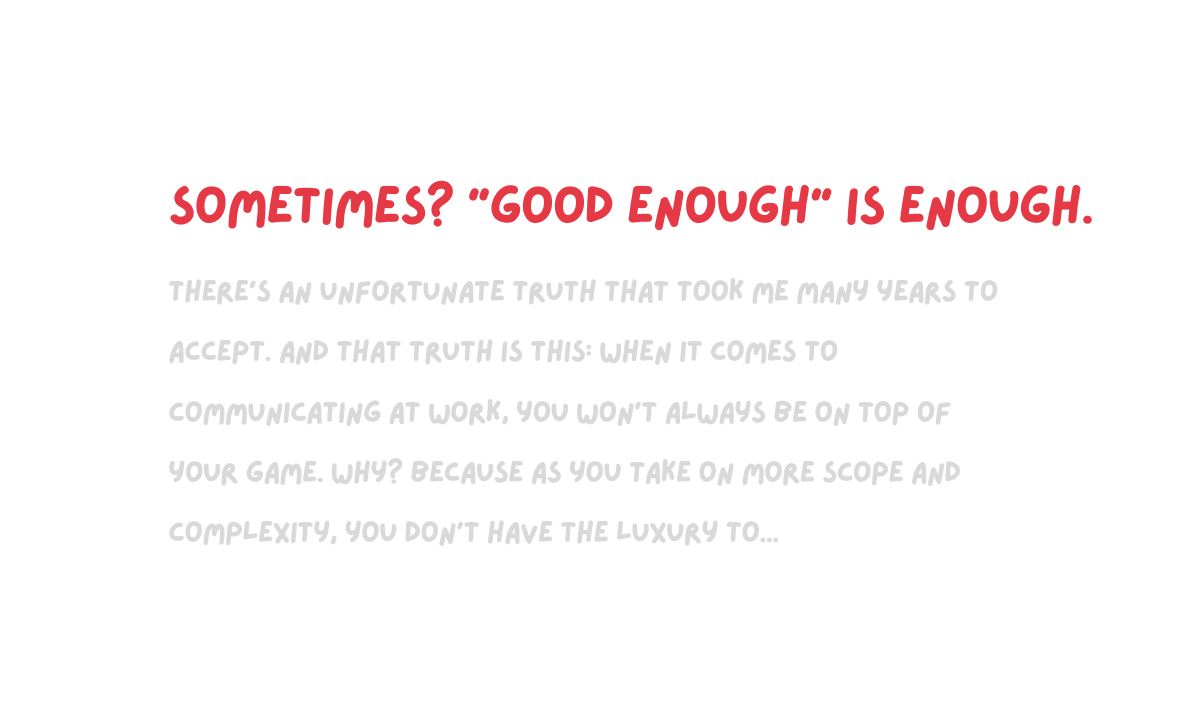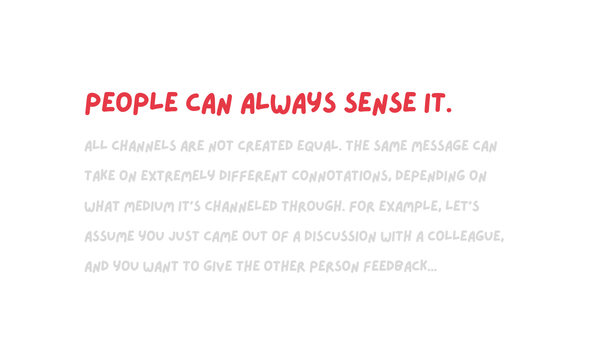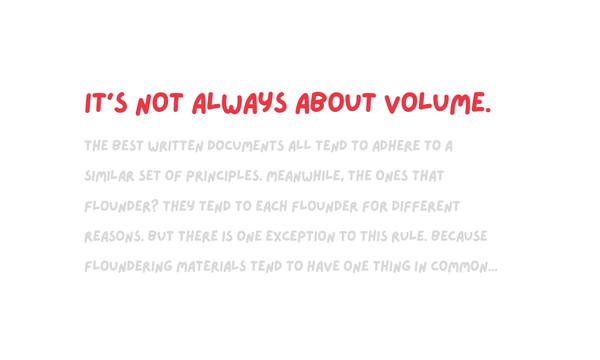Didn't bring your "A" game? These tips will help.

There's an unfortunate truth that took me many years to accept.
And that truth is this: when it comes to communicating at work, you won't always be on top of your game.
Why? Because as you take on more scope and complexity, you don't have the luxury to do everything perfectly. You simply don't have the time.
Specifically, when it comes to your comms at work, you'll realize that:
- You won't be able to ensure your slides are always tight and sharp
- You won't be able to ensure your verbiage is always optimized
- You won't be able to fully rehearse everything you want to say
And when this becomes the reality you have to deal with? It can be quite frustating and unsettling.
Why? Because you likely got to where you are by setting a high bar for yourself.
In fact, you've probably also internalized a bunch of best practices (like these principles) over time. It can be hard to "settle."
Of course, this isn't a bad problem to have. But it then also means that you have a choice to make.
Specifically, when you're not at the top of your game, you can choose to either:
- Stubbornly push yourself to optimize your comms to perfection...
- ...or figure out how to communicate in a way that isn't perfect, but "good enough."
Today's newsletter issue is about how to do the latter.
👋 Join 5000+ readers and subscribe to Herng's Newsletter for free:
#1 You have a lot to say (and that's OK). But stick to 3 things.
When you engage in live discussions, you don't always have the luxury of rehearsing your response. Your answers won't always be perfectly organized either.
That is OK. But it doesn't give you the license to ramble on. You still need to instill enough structure into your comms so that your audience can follow along.
For example, here's a poor way of communicating:
- Them: "What are your thoughts on this business proposal?"
- ❌ You: "I'm skeptical about this one datapoint that powers the revenue estimates, especially since 80% of the business case rides on it. I do like the fact that we're doubling down on these 3 markets though, as that aligns super well with what other teams are investing in. And actually, maybe there's an opportunity to piggyback off of what they're doing, instead of starting something new. But back to your question, it's not that I'm not supportive of the overall direction, because I am..."
Your audience is likely lost by this point. Not because what you're saying isn't valid, but rather because:
- You're jumping around too much. You first articulated an objection, then offered a piece of (encouraging) context, then suggested another idea, then went back to offering a different point of view. Your audience is exhausted trying to keep up.
- You're not providing "timestamps." Your audience has no idea how long your "list" is. When you speak, they have no idea if you're at the 10%, 50%, or 90% mark. That frustrates people.
The good news here? You don't need to always have the perfect framework.
You just need to practice the discipline of (a) sticking to no more than 3 things (b) signposting explicitly as you speak. That's it.
For example:
- Them: "What are your thoughts on this business proposal?"
- ✅ You: "I have 2 quick reactions and 1 question. First reaction is that I am excited about the overall direction, because... Second reaction is that I believe there's an opportunity to scale existing efforts, instead of starting something from scratch... And finally, my 1 key question is this: how confident are we in the revenue model? I'm asking because..."
There's no rocket science here. You're just making it super easy to follow along.
It's not a perfect response – but it's good enough.
#2 Find the 80/20 angle. It's always there.
What if you have a bunch of stuff to say, and you're not confident you can land all of it effectively?
In that case, consider going the opposite direction. Force yourself to land one clear message, instead of trying to land everything and risk fumbling them all.
(Or, for you American football fans out there: if it's 4th down and 8, consider kicking a field goal instead of going for the touchdown.)
You do this by asking yourself questions like:
- If I could only say 1 thing, which message is likely to generate the most outsized influence?
- If I could only say 1 thing, which message is most relevant to our northstar objective?
- If I could only say 1 thing, which message is most likely going to trigger meaningful action?
Because the reality is this: the more things you (are perceived to) say, the less weightage people assign to each of your items. The dilution effect happens naturally.
Therefore, if you're not in a position where you can articulate your thoughts in a well-structured manner? Don't stubbornly cling onto that goal of exhaustiveness.
Instead, focus on landing one or two things well – and deprioritize the rest.
For example: imagine that you're coaching a junior analyst on how to improve a presentation, and there's many things you want fixed. Unfortunately, you don't have time to properly organize your feedback and deliver it in a sharp way.
If you fixate on being exhaustive with your feedback? You might find yourself confusing or even frustrating your recipient. For example:
- ❌ "We need to fix a lot things with this presentation. The flow is a bit disjointed – we need to present the solutions early on in the presentation. Also, the formatting is inconsistent throughout the deck; we really should fix that. We also don't have the right datapoints to support 2 out of our 5 recommendations – it won't land well with this audience. Also..."
Sure, in a perfect world, you'd be able to synthesize all your feedback, articulate it in a sharp way, and ensure all of it gets actioned on perfectly.
But if you're not able to do that (for whatever reason)? Challenge yourself to identify just 1 or 2 things that truly matter.
For example:
- ✅ "Since we're running short on time, let's please make sure that we explicitly call out the proof points behind each of our 5 key recommendations. Please also append the sources in the footnotes. There are a few other areas that could be improved too, but let's discuss those in our post-mortem."
Again, is it a good feeling to settle for a field goal (3 points) when a touchdown (7 points) could still be within reach? Of course not.
But don't think of it as settling. Just think of it as good math.
👋 Subscribe for free to get Herng's newsletter directly in your inbox.
#3 If all else fails? Bias towards action.
I once had a meeting with my manager where I was asked to provide a project update on the spot.
I was familiar with the topic, of course. But I was not fully prepared to give a concise update.
So as I started speaking, I found myself rambling a bit.
Not only was I speaking in a loose, chain-of-thought manner, but I also found myself focusing too much on tactical details.
So what did I decide to do at that point? I told myself to focus on what's next. I asked myself a few questions, such as:
- What's the "so what" here?
- Are there any meaningful next steps here?
- Do I have any asks for my audience?
Because what you'll realize is this: in most situations, you can rarely go wrong by having a bias towards action and focusing on next steps.
"What's next" and "so what" tend to always be the lowest common denominators for everybody.
So if you're not on top of your comms game? Don't fret. Simply remind yourself to anchor on implications for the future, or actions you plan to take. Then work your way backwards.
For example, if you find yourself at risk of doing the following:
- ❌ "For Project X, I met with our vendors last week and delivered acquisition targets for rest of the year. I didn't expect strong pushback, but one valid concern that was raised was this... so then I went to discuss with Finance whether expanding the budget was a possibility, but then they told me that I needed to speak to Product teams to confirm this other thing..." (i.e. chain-of-thought rambling; highly unorganized)
...try challenging yourself to anchor on the "so what" instead. For instance:
- ✅ "For Project X, the tl;dr is that I'm trying to secure 10% more budgets from Finance to ensure we hit acquisition targets for rest of the year. I don't need you to be involved yet, but I might come to you in a week or so to review a draft proposal and incorporate your feedback. FYI, here's the context behind why we're doing this now..."
You will have a much higher chance of securing your audience's attention this way.
👋 Join 5000+ readers and subscribe to Herng's Newsletter for free:
Quick Recap
You won't always be able to bring your "A game" when it comes to communicating at work (either verbally or on paper). And that's OK.
Here are 3 tips that can almost always help get you out of trouble:
- Make it a habit to distill your thoughts down to 2 or 3 things. Then when you speak, signpost explicitly so your audience can follow along.
- Apply the 80/20 rule whenever possible. Ask yourself questions that will help you identify the 1 or 2 messages that carry outsized weight.
- Maintain a heavy bias towards action. Focus on next steps and implications. It is the ultimate currency to ensure attention.


